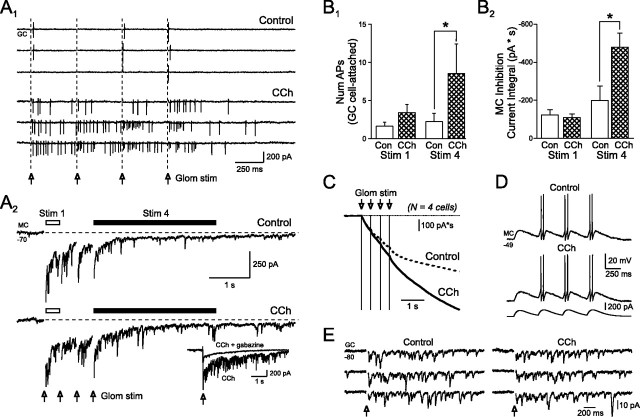Figure 6.
Muscarinic receptor activation potentates synaptically evoked inhibition onto mitral cells. A1, Cell-attached granule cell responses to a train of four glomerular layer stimuli (upward arrows; 400 ms interval; 100 μA) are increased after bath application of CCh (2 μm). Three consecutive responses shown in control conditions and in CCh. A2, Mitral cell responses to a similar train of glomerular shocks also are potentiated by CCh. (GABAA receptor-mediated currents are inward in these experiments because of the CsCl-based internal solution.) The inset shows most of the response to a single glomerular shock in CCh is blocked by 10 μm gabazine (different mitral cell than A2). B, Summary of the selective potentiation of the late response (Stim 4; timing indicated solid bar above traces in A2) by CCh with no significant increase in the early response (Stim 1; open bar) for both cell-attached granule cell recordings (B1) and mitral cell intracellular responses (B2). *p < 0.05. C, Cumulative plot of inhibitory responses in four mitral cells to glomerular shocks (Glom stim) before (dashed line) and after 2 μm CCh (solid line). D, Bath application of 2 μm CCh had no effect on mitral cell intrinsic physiology assessed by responses to slow, phasic stimuli (4 α functions, tau = 100 ms; interval, 400 ms) or depolarizing step stimuli (data not shown). E, Carbachol (2 μm) also had no effect on the barrage of glutamatergic EPSCs evoked in voltage-clamped granule cells after glomerular stimulation. Three consecutive responses are shown in each condition.

